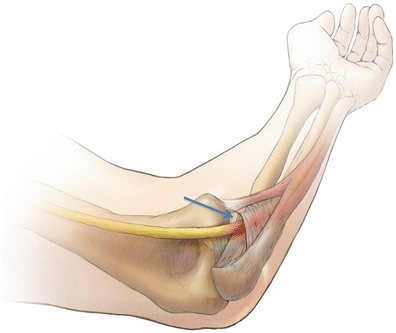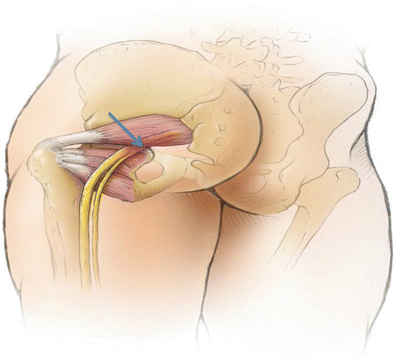Figure 12.1
Schematic drawing showing median nerve compressed (red zone) within the carpal tunnel
Ulnar Nerve Entrapment Within the Cubital Tunnel of the Elbow
The ulnar nerve can become compressed across the elbow within the cubital tunnel, a condition known as cubital tunnel syndrome. It is the second most common nerve entrapment syndrome after CTS. Patients complain of numbness and tingling usually in the ring and little fingers, often exacerbated when the arm is fully flexed across the elbow. Initial treatment involves avoiding direct pressure to the nerve, sometimes facilitated by using an elbow pad, as well as avoiding postures that exacerbate the symptoms, such as using a splint across the elbow when sleeping to keep the arm from flexing. If these measures fail, surgical decompression of the nerve across the elbow can be performed (Allagui et al.). In some usually more severe cases, the ulnar nerve is not only decompressed but also moved or transposed slightly to a more lateral and protected location where its distance across the elbow is shorter, thereby making it less prone to being stretched and put under tension.


Figure 12.2
Schematic drawing showing ulnar nerve becoming compressed (red zone) as it enters the cubital tunnel across the elbow
Thoracic Outlet Syndrome
Thoracic Outlet Sundrome (TOS) occurs when the nerves in the neck, also known as the brachial plexus (called neurogenic TOS), or adjacent large blood vessels such as the subclavian artery (called vascular TOS) become compressed by adjacent bone, connective tissue, and/or muscular tissue. TOS causes pain in the neck and the shoulder that can radiate down the arm into the hand and fingers, as well as numbness and weakness in more advanced cases. The lower portion of the brachial plexus supplying the hand muscles, also known as the lower trunk, is most often involved. These symptoms and findings are usually made worse with arm abduction at the shoulder such as when the patient raises or uses his hand above shoulder level. An extra cervical rib or enlarged transverse process of the spine at the C7/T1 level predisposes patients to developing this syndrome. In addition to physical therapy aimed at stretching out the scalene muscles that may lessen nerve compression, image guided injection of Botox into the scalene muscles which causes reversible paralysis may be helpful both to diagnose and treat this condition. In cases, where these treatments fail, a surgical decompression may be helpful.
Pronator Teres Syndrome
Median nerve compression in the proximal forearm is referred to as pronator teres syndrome. It is rare compared to carpal tunnel syndrome and causes pain in the forearm as well as weakness in flexing the thumb and index finger. Patients with pronator teres syndrome usually have difficulty turning their palm downwards (pronation) against resistance because this action is very painful. Treatment of pronator teres syndrome includes avoidance of painful movements, as well as steroid injections and massage therapy, and, when these measures fail, surgical decompression of the nerve (Zancolli et al.). The diagnosis is confirmed with either electro diagnostic or imaging studies.
Radial Tunnel Syndrome
Radial Tunnel Syndrome is due to compression of the radial nerve in the proximal forearm which causes pain when turning the palm up (supination) against resistance. Treatment of this condition involves avoidance of exacerbating movements as well as non-steroidal anti-inflammatory drugs, massage therapy, and surgery when conservative measures fail (Naam et al.).
Guyon’s Canal Syndrome
Guyon’s Canal Syndrome results when the ulnar nerve becomes trapped in a space called the Guyon’s canal in the hand. Patients with this syndrome initially complain of a sensation of pins and needles in the ring and pinky fingers and may progress to a reduction in hand function. Guyon’s canal syndrome is very commonly seen in cyclists who experience a lot of pressure against the palm area when gripping the handlebars. Treatment for this syndrome includes avoidance of exacerbating postures as well as non-steroidal anti-inflammatory drugs, massage therapy, and injection of steroids in the canal. When these therapeutic measures fail, surgical decompression can be performed.
Pyriformis Syndrome
Pyriformis Syndrome is characterized by compression of the sciatic nerve by the overlying pyriformis muscle which may fibrose, located deep in the buttock. Patients with this syndrome will present with deep buttock pain and discomfort, and often pain radiating down the posterior thigh and lower leg (sciatica), exacerbated by pressure on the buttock such as when sitting for long periods of time. Treatment of this condition involves physical therapy directed at stretching out the pyriformis muscle. As in TOS, image guided injection of Botox into the pyriformis muscle combined with physical therapy may be useful to both diagnose and treat this condition. If these measures fail, a surgical decompression in which the pyriformis muscle is cut may prove helpful.








